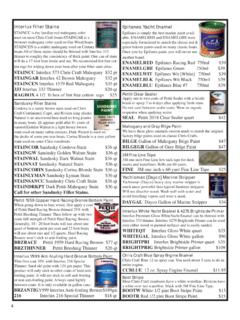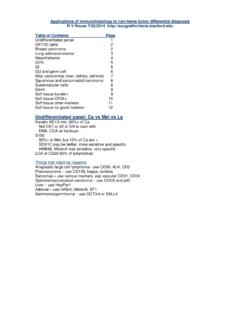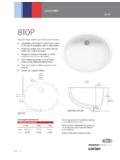Transcription of Rust Coloured Stains on the surface of Exposed Aggregate ...
1 TJM Operations Pty Ltd t/a Vic Mix 7-Mar-10 Prepared by: Joe Pietrosanto, B Eng(civil) Page 1 of 6 DISCLAIMER Conclusions and/or recommendations contained in this report have been based on information available at the time of its preparation. Additional information could result in the revision of these conclusions and/or recommendations. This report may only be reproduced in full. Rust Coloured Stains on the surface of Exposed Aggregate Concrete What is causing the Rust Coloured Stains There are a multitude of causes that can result in Rust Coloured Stains on the surface of concrete. This document deals specifically with rust Coloured Stains created by Ironstone on the surface of Exposed Aggregate Concrete. Ironstone is the common term used to describe unstable Aggregate (stone) particles that are rich in iron oxide minerals. These stones are generally dark grey to black in appearance (once oxidation has commenced) and are more commonly found in river pebbles.
2 It is believed that these minerals are a form of iron pyrite (related to fools gold) that begins to rapidly oxidise on exposure to air and moisture. Pyrite is usually found in quartz veins, sedimentary rock and metamorphic rock as well as in coal beds and as a replacement mineral in fossils. Are there controls for limiting Ironstone Natural geological processes are responsible for producing most naturally derived construction materials such as sand and aggregates commonly used in the production of concrete. Ironstone or Pyrite is just one mineral in thousands that can be present in any single source of sand or stone and only detailed and exhaustive petrographic analysis can identify the presence and nature of such minerals and its presence at low percentages does not preclude the source stone/sand from general construction purposes. TJM Operations Pty Ltd t/a Vic Mix 7-Mar-10 Prepared by: Joe Pietrosanto, B Eng(civil) Page 2 of 6 DISCLAIMER Conclusions and/or recommendations contained in this report have been based on information available at the time of its preparation.
3 Additional information could result in the revision of these conclusions and/or recommendations. This report may only be reproduced in full. Detailed description of Ironstone deterioration on the surface of concrete The presence of Ironstone in concrete is easily identified. In most cases, the presence of such particles near the surface of Exposed Aggregate will become apparent over a short period of time. The particles themselves are generally dark in appearance and hard to visually differentiate from other stone particles prior to oxidisation, but when the stone begins to breakdown, a (rust Coloured ) leachate stream is produced that Stains the surrounding concrete and marks the location of each and every ironstone particle. Decomposition and staining occurs near the surface of the concrete only where the mineral is Exposed to air and water. It is noted that particles fully encased in the concrete rarely decomposes - presumably due to the protection offered by the concrete through significantly reducing exposure to air & moisture in a depassivated, alkaline cementitious structure.
4 A typical incidence of Ironstone after commencement of oxidisation is typified by: a. A fractured remain of dark grey to black 3 to 14 mm size Aggregate particle at the centre of a small, shallow, micro crater type hole on the surface where the stain has maximum intensity and the unsound particle has erupted and is in the process of disintegration. b. A dark reddish brown stain on an otherwise sound concrete surface . Repair Procedure It is quite possible to just remove the rust Coloured Stains with a dilute solution of iron-stain remover (or an acid, although it's not as controllable as the proprietary solutions). But to prevent the staining from reoccurring you have to remove the offending Aggregate particle first. What follows is a detailed procedure for identification, temporary marking, removal of unsound particles, chemical treatment of Stains , and fixing of new particles into place. TJM Operations Pty Ltd t/a Vic Mix 7-Mar-10 Prepared by: Joe Pietrosanto, B Eng(civil) Page 3 of 6 DISCLAIMER Conclusions and/or recommendations contained in this report have been based on information available at the time of its preparation.
5 Additional information could result in the revision of these conclusions and/or recommendations. This report may only be reproduced in full. Step1 Identification and Marking Given the heavy staining caused by the Ironstone, it may seem that identification and marking is completely redundant and unnecessary. However, once you begin the process of repair, you will realize how difficult it becomes to relocate each particle being treated, particularly when the surface area being treated is quite large. A Coloured self adhesive tape (such is commonly used for paint masking) is an ideal method for temporarily marking the location of Ironstone particles to be repaired. Start in one corner of the pavement, and methodically scan the surface , placing small pieces of the highly visible tape a few centimetres away from the epicentre of each identified Ironstone particle. Do not rush this step, it will only slow you down later when you realise you have missed particles and you have to keep stopping to ensure you mark what you have found before you lose sight of it again some incidences of Ironstone are very small and staining may be light or not advanced enough to draw immediate attention to itself.
6 This raises one other issue how long has the pavement been in service. Attempting to repair after the first indication of rust staining may lead to having to carry out this repair procedure numerous times because insufficient time has been allowed for all incidences of Ironstone to erupt and produce a stain on the surrounding surface . Trying to identify particles that have not erupted is just not practical particularly when other perfectly sound particles are of a similar appearance only analysis of samples examined under a microscope will have any chance of differentiating these particles. Clearly, this is not practical or cost effective. TJM Operations Pty Ltd t/a Vic Mix 7-Mar-10 Prepared by: Joe Pietrosanto, B Eng(civil) Page 4 of 6 DISCLAIMER Conclusions and/or recommendations contained in this report have been based on information available at the time of its preparation. Additional information could result in the revision of these conclusions and/or recommendations.
7 This report may only be reproduced in full. Step2 Removal of Ironstone and stain trail Prior to trying to clean the stain, it is important to remove the source of the stain the Ironstone particle. The particle is best removed mechanically by either: a. Drilling the particle out of the concrete using a masonry bit; or b. Breaking the particle out of the concrete with a hard pointed implement a nail hole punch and hammer works well for this. Take some care not to over-excavate the area. Concrete is a brittle material and excessive and uncontrolled force will cause other particles to be removed along with the unsound one. SAFETY PRECAUTION: Be sure to take appropriate safety precautions. A pair of comfortable gloves will prevent annoying scrapes and other minor injuries associated with hammers and sharp implements. More importantly, a pair of safety glasses may prevent an annoying and often painful injury to the eyes caused by a chipped fragment of concrete or stone flying into it.
8 The aim at this stage is to only remove unsound ironstone particles and to limit damage to the surrounding paste and other stones. This will help to reduce the visibility of the repair when complete. With some time and practice, you should be able to quickly punch out the dark ironstone leaving behind a small crater as can be seen in the photograph above. For large jobs with a team of people performing the repairs, it is recommended that the job is divided into working areas and that each operator draw an X on the marking tape to indicate completion of this step. This will ensure that none are missed and save time later. Once all Ironstone particles have been removed, chemical treatment of the stain can be undertaken. There are numerous products available that can effectively clean Stains from concrete. The most commonly used cleaners contain an acid. Acids are particularly reactive against the alkaline nature of common, lime based concrete.
9 TJM Operations Pty Ltd t/a Vic Mix 7-Mar-10 Prepared by: Joe Pietrosanto, B Eng(civil) Page 5 of 6 DISCLAIMER Conclusions and/or recommendations contained in this report have been based on information available at the time of its preparation. Additional information could result in the revision of these conclusions and/or recommendations. This report may only be reproduced in full. The most effective acid for removing rust type Stains is Oxalic acid, but it is not as commonly available in its pure form, rather as a constituent of propriety rust removing and cleaning products. Other acids (such as: Muriatic or hydrochloric acid are more commonly available through hardware stores and pool shops) can be effective, but always begin by testing in an inconspicuous region and see what the results are before you carry on with the rest of the stained areas. Trial and error is sometimes needed to understand if any side effects may occur with other Be careful when working around some bricks, pavers and stone blocks.
10 Depending upon their composition, certain materials can be sensitive to acids and are easily damaged or marked. You'd be risking damaging or staining the stone with acid-burn, "vanadium stain", while at the same time, possibly not completely removing the rust stain. Also, never use a metal-bristle brush with acid, on some bricks and stone, it will leave a lot more staining and may be too abrasive on some softer surfaces . Any brush you use should be stiff nylon bristle or wood fibre. Once you have established confidence in a cleaning solution that will remove the rust stain without any significant side effects, treat each marked area systematically so as not to miss any. Pay attention to the time you leave your cleaning solution on there, and make sure it does not dry out in the meantime. SAFETY PRECAUTION: Be sure to take appropriate safety precautions. Acids and acid based cleaners are particularly harmful to humans. Read any safety directions provided by the supplier and closely follow the recommended instructions.









